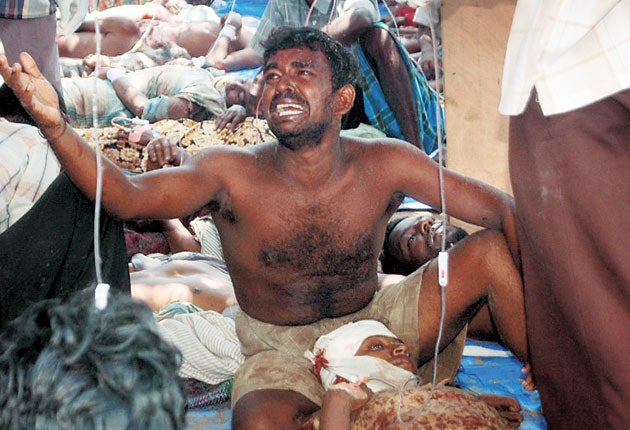Tamil rebels surrender – but hunt for their leader goes on
Prabhakaran warned that he 'must now face the consequences of his actions'

The army in Sri Lanka said yesterday that two prominent members of the Liberation Tigers of Tamil Eelam (LTTE) had surrendered, as the military advanced on the shrinking patch of territory the rebels still hold on the island's north-east coast.
With the number of Tamil civilians fleeing the conflict zone surpassing 100,000 in three days, according to army estimates, President Mahinda Rajapaksa said the LTTE's supreme leader Velupillai Prabhakaran had lost any chance of being pardoned.
The men the military says have surrendered are Daya Master, a one-time schoolteacher who for years was the Tamil Tigers' voice to the English-speaking world, and a translator named George, who worked for the late head of their political wing.
"The two came out with civilians and surrendered to the army," said Sri Lanka's military spokesman, Brigadier Udaya Nanayakkara, "They were not trying to escape." Nor had they tried to commit suicide using cyanide vials around their neck as loyal followers of Mr Prabhakaran, the group's founder-leader, are famously schooled to do. The brigadier said there might be rehabilitation processes available to the two men, but it was for the government to decide.
Meanwhile President Rajapaksa said the reclusive Mr Prabhakaran had spurned the possibility of pardon and "must now face the consequences of his acts". The government believes it is within days of delivering a final blow to the LTTE and ending 25 years of civil war, which has pitted the Sinhalese-dominated army against the feared guerrilla group which calls itself the sole legitimate representative of the island's Tamil minority. Many observers point out, however, that whatever the successes of the current military campaign, ceasefires have failed in the past, and this is an island still plagued by a bitter ethnic divide which will eventually need a political solution.
The rebels have now been pushed back into a tiny, sweltering coastal pocket, into which the military says it has just made further, sweeping inroads. It is thought that perhaps 100,000 civilians remain cramped in makeshift shelters completely exposed to the crossfire of what the government believes is the endgame of Asia's longest running conflict. Independent verification of events in the conflict zone is difficult to come by as journalists have been prevented from having access.
However aid workers say that many of the people who have escaped since the army blasted through a rebel fortification early on Monday are in a wretched state, sick and badly wounded. Staff of the Médecins sans Frontières (MSF) charity working at one of the hospitals treating the refugees, in the town of Vavuniya, say most of their injuries come from landmines, shrapnel and shellfire.
Vavuniya lies about 65 miles inland from the conflict zone, but MSF quoted its mental health worker, Karen Stewart, as saying the shelling could be heard even from there. "Almost everyone has left someone behind in the conflict area," she said. "Probably 85 per cent of the people I've talked to have witnessed horrific things, like being in a bunker, and suddenly a shell goes and it's killed half the people in the bunker. Someone else I spoke to told me how she went out to find some water and when she came back everyone in her bunker was dead."
Ms Stewart described the situation in the main hospital as chaotic, with 1,200 patients but a bed capacity of just over 400, and many lying on the floor.
Near Vavuniya, the authorities are using schools to accommodate refugees newly bused in from the war zone. They are building what are called relief villages to house them but are struggling to allocate enough shelter with proper sanitation.
As concern for those left behind mounts, governments including Britain and India have urged Sri Lanka to allow a further pause in their offensive and let more civilians out. But the authorities in Colombo say there is now no going back, and insist that the mass exodus of civilians – in far greater numbers than they had ever acknowledged were trapped inside – means another cessation of their campaign is unnecessary.
Yesterday more criticism came from Washington. The Secretary of State, Hillary Clinton, said: "I think that the Sri Lankan government knows that the entire world is very disappointed that, in its efforts to end what it sees as 25 years of conflict, it is causing such untold suffering." The UN Security Council was last night expected to hold an informal meeting on Sri Lanka. China and Russia so far have opposed attempts to bring up Sri Lanka officially at the council.
Dead or alive? The head of the Tamil Tigers
Will the leader of the Tamil Tigers go down with his troops? Is he still alive? For more than 30 years Velupillai Prabhakaran has evaded capture in the jungles of northern Sri Lanka where he has waged a brutal military campaign to create a Tamil homeland.
The 54-year-old founder of the Liberation Tigers of Tamil Eelam (LTTE) has ordered his bodyguards to kill him if he is cornered. Like members of his infamous Black Tiger suicide squad, Prabhakaran also wears cyanide capsules around his neck at all times. Critics describe a ruthless terrorist leader who brutally suppressed any Tamil opposition to the Tigers. But to millions of Tamils he is lionised as a freedom fighter and lovingly referred to as "Thamby" (little brother).
But whether he is still leading the Tigers' last stand, or is even alive, remains to be seen. Both the military and the LTTE insist that he is on the front lines but some speculate he fled weeks ago in a boat during heavy fighting and is in hiding in south India, Malaysia or Cambodia.
Join our commenting forum
Join thought-provoking conversations, follow other Independent readers and see their replies
Comments
Bookmark popover
Removed from bookmarks